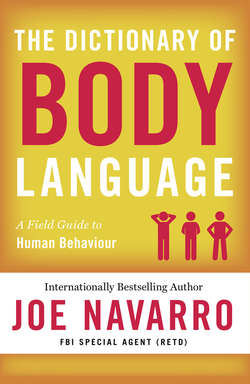Читать книгу The Dictionary of Body Language - Joe Navarro, Joe Navarro Toni Sciarra Poynter - Страница 7
The Eyebrows
ОглавлениеThe eyebrows lie just above the supraorbital arches of the eye sockets and serve a variety of purposes. They protect our eyes from dust, light, and moisture, but they also communicate how we feel. From an early age we rely on people’s eyebrows to help us interpret their facial expressions. And in many cultures, eyebrows are an aesthetic concern: something to be tweezed, shaped, plucked, colored, highlighted, waxed, stylized, removed, or extenuated. Like the rest of our face, the eyebrows are controlled by a variety of muscles (corrugator supercilii principally, but also the nasalis and levator labii superioris from our nose), and thus can be very expressive and communicate exquisitely our feelings.
30. EYEBROW ARCHING/FLASHING (HAPPY)—Eyebrow arching or flashing conveys excitement (such as when greeting a close friend) or the recognition of something pleasing. We arch our brows in less than one-fifth of a second. It is a gravity-defying behavior, as it is performed in an upward direction, and as with most gravity-defying behaviors, it signifies something positive. Babies just a few months old light up when their mother flashes her eyebrows. Here is a great behavior to let others know we care and are happy to see them. A happy eyebrow flash can be immensely useful and powerful in everyday situations both at home and at work.
31. EYEBROW GREETINGS—We flash our eyebrows when we recognize someone we know and cannot speak up at that moment, or simply to recognize a person’s presence, with or without a smile, depending on circumstances. We are quick to notice when this courtesy is not extended to us, for example, when we enter a store and the clerk makes no effort to establish any kind of eye contact. We can let others know we value them, though we may be occupied, with a very simple eyebrow flash.
32. EYEBROW ARCHING (TENSE)—This occurs when a person is presented with an unwanted surprise or shock. Coupled with other behaviors such as a tense face or lip compression, it can let us know someone has experienced something very negative. It is the tension in the muscles that control the eyebrows that differentiates this behavior from the eyebrow greeting described above and it is held for a few seconds longer.
33. EYEBROW ARCHING (CHIN TOWARD NECK)—We arch our eyebrows with our mouths closed, chin toward the neck when we hear something we immediately question or are very surprised to hear or learn. When we witness an embarrassing situation we also employ this behavior, as if to say, “I heard that and I didn’t like it.” It is a look teachers often give to misbehaving students.
34. EYEBROW ASYMMETRY—People use this signal when they have doubts or uncertainty. One eyebrow will arch high, while the other remains in the normal position or sinks lower. Asymmetry signals that the person is questioning or doubting what is being said. The actor Jack Nicholson is famous for questioning what others say, on- and offscreen, by this method.
35. EYEBROW NARROWING/KNITTING—The area between the eyes and just above the nose is called the glabella, and when the glabella becomes narrow or furrowed, it usually means there is an issue, concern, or dislike. This universal sign may happen very quickly and thus can be difficult to detect, but it is an accurate reflection of sentiments. Some people will knit their brow when they hear something troubling or are trying to make sense of what they’re being told. The sentiment is communicated with the >< emoji.
